Jump To: What is a Piezo Motor | Electric Motor Uses | Piezo Motor Styles
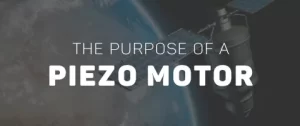
People are often curious about what a piezoelectric motor is and the best application of these dense ceramic elements in a given application. While the piezo effect has been studied by scientists for many years, starting back in 1880, creating a motor and industrial product reliable enough for use in different designs has taken many years.
The piezo effect is the unique ability of certain materials to respond to an electrical charge with motion, as well as generate an electric signal when mechanical stress is applied. This phenomenon was studied in detail during the early 1900s. This research into the piezo principle allowed scientists to discover an entire subset of materials that were previously unknown in their quest for the best piezo elements.
In World War I and II, scientists were able to use the piezoelectric effect in order to create the first underwater submarine detection systems based on these current sensing elements. Later, in 1951, the Japanese were able to expand the boundaries of the motor technology in order to push the TV, radio and communication industries forward. The basic principle of a piezoelectric connection from motion and mechanical energy to an electric based signal allowed people to transfer their voice into electrical fields for TV, movies, video games and more — all in a short span of time. This truly was a revolutionary step in getting technology that worked for everyday applications based on this scientific principle.
Tension and compression generated a voltage of opposite polarity, and these are able to move in direct proportion to the applied force in order to move the motor. These devices rely on piezoelectric materials — such as Berlinite, Barium Titanate, and Lead Zirconate Titanate — to operate in a wide variety of environments. Electricity can be applied to this material and the motor can move in extremely precise increments to achieve micrometer- or even nanometer-level resolution changes. Motors can be designed in a linear or rotary structure that contributes to the overall system goals.
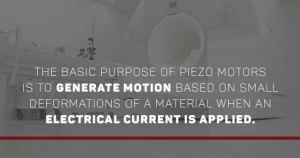
A piezo motor is a device that can be used for a variety of precision applications in many different fields. The basic purpose of piezo motors is to generate motion based on small deformations of a material when an electrical current is applied. In addition, small motion levels based on different frequency oscillation can create a small electric current in each motor.
In single- and multi-axis configurations, they contain a precise movement that is repeatable and reliable. This is a desirable quality, and because of their small size, they can be used in a variety of locations where other solutions may be limited. For instance, piezo motors have no trouble operating in a vacuum environment without the typical constraints other motor systems experience. In addition, since electricity is applied directly to the transforming material, piezo motors can often be used in magnetic field environments, such as MRI machines, that would be sensitive to other kinds of mechanical equipment.
Precision positioning and motion control applications have benefited greatly from the use of piezoelectric equipment and motors, since they have some of the most accurate movements down to the nanometer level. In environments with little room for error, having a repeatable motor positioning system in place can be the deciding factor between other alternative solutions.
Piezoelectric motors have a design that favors high-voltage electrical feeds, which are able to interface with the elements and the different materials inside of the motors in order to produce the desired effect. This voltage is one of the most critical elements of the system, since having the correct input is critical to achieving motion due to the constant ratio found with the principle of piezoelectric systems.
These motors can be configured in many different ways to meet the needs of a specific system, but they can be triggered to run off DC or AC current in order to offer the most power or the highest-resolution movements. Having the ability to feed controls to these motors from a central amplifier and system means they can be custom-designed with digital programming or connected to tie into existing analog data streams.
What is the point of a piezo motor over the available alternatives? There are numerous reasons why a piezo motor is a great fit for a system design. For a start, they are by nature energy-efficient, since electricity only needs to be used when movement is required. With no electric current sent to a piezo motor system, the device actually maintains its position and is able to stay locked in place due to the science behind the piezo effect.
In applications where sensors and other transforming acts are important, a piezo system can determine and output electrical value for high-frequency waves and sound waves to send to a controller device. They can be used for closed-loop applications with servo motors in order to create small movements according to a central processing unit. Furthermore, motors can operate in an actuation mode rather than a traditional mechanized method, allowing maximum flexibility for system designers and planners. Piezo motor characteristics mean a holding force is applied on the object when there is no electrical current, so this braking device can be used to reduce motion in a system as well.
The piezoelectric effect is very useful in motors with a need for an electrical frequency generation of a specific number. Likewise, small and precise piezo motors can be used for scientific instruments such as microbalances in order to accurately move and measure equipment and data. Specifically, scientific instruments such as scanning probe microscopes and atomic resolution devices use piezo motors to move optical parts for focusing and zooming.
Since very high voltage levels are able to be directly tied to only tiny changes in the width of the crystal at the core of each motor, better than millimeter precision can be achieved in movements for these devices. This makes these motors perfect for use in the following applications:
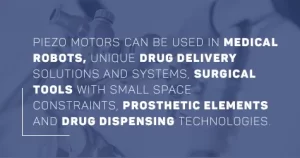
Medical and Lab Equipment: Piezo motors can be used in medical robots, unique drug delivery solutions and systems, surgical tools with small space constraints, prosthetic elements and drug dispensing technologies. The general ease of implementation and the wide variety of motor styles make piezoelectric characteristics the best choice for these lab environments.
Instrumentation and Control: Accuracy and detailed precision in the micrometer range is a huge advantage of a piezo motor system vs. a traditional servo or assisted setup. Having a motor that can easily reproduce a test procedure or move in an identical pattern during every single trial is critical for modern measurement and the testing of technology.
Aerospace and Defense: There is a huge number of applications that electric piezo motors can serve in aerospace or defense, from small unmanned drones and robots to satellites and rockets that enter orbit or outer space. These high-precision motors are able to move in all extreme environments, as well as send signals, due to the mechanical nature of their connection to the system.
Optics and Photonics: Whether it is an intermittent aperture optic system or a filter, lens or even a reflector, having a piezoelectric motor controlling the movement and adjustments in an optical system can be perfect for the small changes and precise nature of the operation. In order to focus, zoom or change the view, having a drive application based on a piezoelectric motor can be critical for success in your machine.
While there are many different kinds of piezoelectric motors, there are a few common solutions — including ultrasonic piezo motors, stepping piezo motors and inertial piezo motors. Each has a unique design for a specific application, but all of them provide precision, repeatable movements and reliable operation. Due to this extreme precision, the piezo motor characteristics have allowed industrial applications to take advantage of them for over 40 years.
There are several unique types of piezo motors that can be found in scientific equipment, lab instruments and data devices that need high-tolerance nano motion. Here are a few of the typical designs:
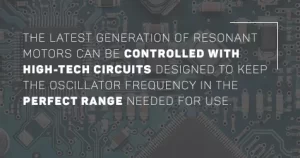
Resonant motors: Also known as ultrasonic piezo motors, these are used for high-speed movements that are very complex and precise. They can be placed in areas that are significantly smaller than normal operating conditions due to their screwless design with minimal linkages and structures. The latest generation of resonant motors can be controlled with high-tech circuits designed to keep the oscillator frequency in the perfect range needed for use. These can move up to 1,000 mm/sec in some cases and have a simple and versatile design.
Piezo walk motors: Also called stepping motors, walk motors are able to exert a high force with a level of precision that is unmatched by traditional motor components. They have a stability that can be used in designs to keep movements isolated to relevant components. They operate at a low speed in this application, but they have the power to move loads along the step-based path as needed. These are able to act in longitudinal and transverse directions, and the motion can be transferred to the desired surface with precision every time. Optic positioning and sample positioning in electron microscopy are some of the many ways that a walking drive-type motor can be used to get the results you are looking for.
Inertial piezo-style motors: Also called stick-slip motors, these are compact designs based on sliding friction between two elements. They provide a motor design that is high-resolution and allows the natural break inherent in the design of a piezo motor to hold in your application and keep things stable. These can be used in a variety of situations, but they are often known for being energy-saving and a low-cost option for an electronic drive. The motor is only limited by the range of the design and carrier, so the overall level of complexity is generally limited.
While all of these are common uses for a piezo motor, designers oftentimes require a custom solution, since space and budget constraints demand a high level of integration with the rest of the device.
APC International, Ltd. has years of experience in dealing with the latest advances in this technology and can help you find the exact motor design to fit any system’s needs and budget.
What Are the Strengths and Weaknesses of Piezo Motors?
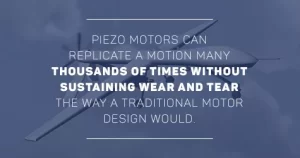
As we’ve seen, piezo motors can be used in a variety of applications due to their accurate movements and the compact nature of their design. Piezo motors can replicate a motion many thousands of times without sustaining wear and tear the way a traditional motor design would. This is due to the deforming and reactivity of the ceramic and other materials.
Another reason why piezo characteristics are leveraged in different situations is their ability to stack and achieve a wider range of motion and scale than conventional motor setups. Having the ability to extend the plane of motion by simply adding another piezo motor on top of an existing unit means manufacturers can scale these systems to large proportions while still taking advantage of their small number of moving parts, high reliability and extreme accuracy of movement.
Another advantage of a piezo motor system is the ability to utilize both digital and analog DSP systems in their design. These motors were designed to receive an electrical signal in order to complete their movement and they can be quickly connected to either type of system in order to interface and operate remotely. Since the displacement or movement of the element is proportional to the drive voltage, as long as the sending device can generate the correct voltage range, a piezo motor will happily operate to control elements without requiring any additional components.
Lastly, a piezo motor system has only ceramic design components in its structure. This means that ferrous materials, copper and other pieces of metal or plastic that could harm the environment are removed and the structure can be used knowing it is “clean and green.” The high torque produced by the motor means there are no compromises needed in order to create a design with high-resolution movement, reliable operation and a structure that is scalable at the same time. This cannot be said of other electric small motor technologies.
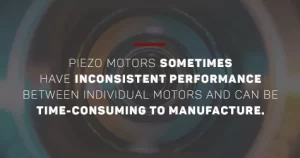
Piezo motors do have some inherent weaknesses depending on what application is desired, however — and it is important to understand these limitations before utilizing them in your design. One disadvantage of a piezoelectric motor is that they can sometimes have inconsistent performance between individual motors. This means you can buy two identically-designed units but they may have slight differences in the movement planes due to the inherent design and reliance on the voltage applied to the material inside. While one motor will repeat a motion with no issues and be accurate when measured against itself, it may not be able to directly compare with other similar parts.
One other issue with piezo motors is they can be time-consuming to manufacture compared with other motor technologies. Each must be made with specific materials and then be individually checked to ensure quality. Compared to mass-produced motors, these take more time and energy, which generally makes them more expensive than some other motor options.
However, for their average use, the specific nature of the design and the wide variety of constraints placed on a system allow piezo motors to be the best choice for a variety of projects.
Whether you are looking for a specific type of piezo motor for your project or are looking to learn more about how these motor designs can fit your system, the team at APC International has extensive knowledge of the market and how these ceramic shapes and devices can help you. Contact us today to learn more about the products we offer and request a free quote for a piezoelectric motor from APC International today!